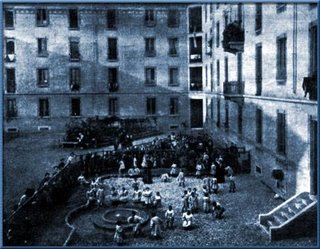The 3-6 age group is where it all began, back at the first Montessori school (Casa dei Bambini, or “Children’s House”) in a housing project on the outskirts of Rome, Italy. The reason for starting with this age group was simple: children age seven and older attended school, while younger children ran around unsupervised.
 The Italian government realized that these younger children needed some direction and instruction, and asked Dr. Montessori to start a school for them. She was breaking new ground with this school, as up until now many people believed that children younger than seven couldn’t actually learn anything. (Picture: the opening ceremonies on Jan. 6th, 1907, at the first Casa dei Bambini).
The Italian government realized that these younger children needed some direction and instruction, and asked Dr. Montessori to start a school for them. She was breaking new ground with this school, as up until now many people believed that children younger than seven couldn’t actually learn anything. (Picture: the opening ceremonies on Jan. 6th, 1907, at the first Casa dei Bambini).
Even though her theories grew to include both children both older and younger than the 3-6 age group, that period of learning is still the foundation of the Montessori method, and is the most widely associated with Montessori even today. It was here that the first true Montessori materials were developed – the ones we use even today: the pink tower, the brown stair, the cylinder blocks, the color tablets. Here children were first given their own “real” tools for cleaning: brooms, sponges, washcloths, mops, and buckets.
In this enriched environment, children who were heretofore completely unschooled began to thrive. They learned to care for themselves and their bodies, for the environment, and they began to teach themselves how to read and perform mathematical operations. This was a living laboratory where Dr. Montessori could make careful observations of the children as they worked.
Many very crucial concepts arose from this first school: the idea of following the child, of respect for the child, the absorbent mind, the prepared environment, and the importance of children working with their hands to obtain information about the world around them.
As she observed, Maria Montessori realized that the children in her care could not actually be taught anything, but they were able to learn on their own if provided with the right materials and presentations. She realized the importance of precise presentations; for many of us, this seems to be overly fussy, and yet she saw how the children at this age were in a sensitive period for precise movements.
The 0-3 age group will naturally have some leeway in how the materials are used, and the elementary child has moved on to being captivated by ideas rather than materials, but presentations given to the 3-6 age child should be accurate and fastidious. It’s sometimes daunting to sit down next to a child of this age group and show them how to use a certain material.
There’s a reason that 3-6 directresses practice the materials often and usually review the steps of presentations before they give them. It’s not wrong to feel a little bit of pressure when presenting to this age group; it keeps you on your toes so that you don’t become vague or sloppy with your movements and directions.
There’s a lot more to say about 3-6, so I’m excited to embark on this adventure and I welcome your questions and comments!

